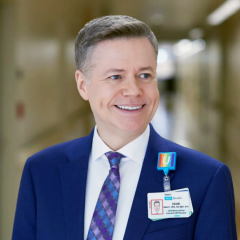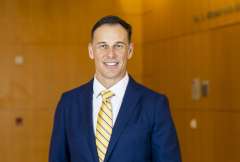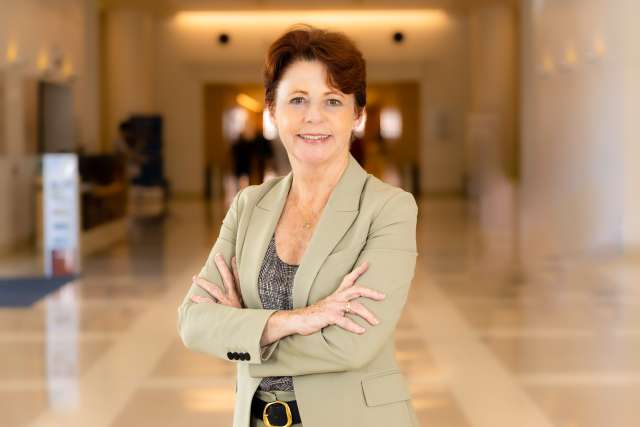It is a dynamic and transformative period for UCLA Health Nursing. The newly opened UCLA West Valley Medical Center brings exciting opportunities for innovation and expands UCLA Health's ability to serve more patients. Both Ronald Reagan UCLA Medical Center and UCLA Santa Monica Medical Center are in the process of renewing their Magnet designations, showcasing their continued commitment to nursing excellence. Additionally, UCLA Health is expanding its clinics into South Los Angeles to increase access to health care in underserved neighborhoods, and is gearing up to address a critical need with the development of a new, world-class psychiatric facility. Our four chief nursing officers are excited to share their plans and initiatives for the future, and the developments and improvements in nursing care that lie ahead.
UCLA Health is renowned for its exemplary nursing care, attracting patients from around the world. This excellence is further demonstrated by the multiple Magnet designations earned by its three hospitals. Currently, documents are being compiled for Ronald Reagan UCLA Medical Center’s fifth Magnet designation and UCLA Santa Monica Medical Center’s third designation. Recently, Resnick Neuropsychiatric Hospital at UCLA proudly achieved its second designation.
“We are very busy capturing exemplary nursing care and nursing excellence on paper and in graphs, in preparation for the Magnet committee’s site visits,” says Chief Nursing Executive Karen Grimley. “To have three organizations credentialed multiple times with a Magnet designation is very impressive. It essentially tells you that our commitment to providing nursing excellence and patient-centered care is our number one priority.”
For the immediate future, Dr. Grimley’s goal is to onboard nursing staff from the newly acquired UCLA West Valley Medical Center (formerly West Hills Medical Center). “We know that West Valley is going to bring some wonderful ideas and opportunities for us, and we want to stand ready to incorporate those into who we are as UCLA Health Nursing,” she says.
Further plans include:
- Continued commitment to the safety and well-being of patients and staff through the A Safer U initiative; this nurse-led interprofessional effort has engaged nurses from the bedside and clinics to design programs and provide education and tools to reduce the incidences of workplace violence
- Launching the Certified Nurse Assistant Training Program, designed in collaboration with nursing staff and Santa Monica College, through which UCLA Health employees can gain the skills and knowledge to become certified nursing assistants and apply for administrative clinical care partner roles at UCLA Health
- Continued partnership with the UCLA School of Nursing, with nurses from UCLA Health on faculty and serving as instructors and preceptors in clinical environments across the system
- Establishing partnerships with other schools to enhance pipeline development while continuing to improve the ability to onboard and cross-train nurses anywhere within UCLA Health
- Investing in our workforce through programs such as Reigniting the Spirit of Caring, leadership fellowships for experienced nurses and the Nurse Residency Program for new graduates; creating new orientations for different specialties to enhance cross-training and provide a career home for nursing staff
- Exploring the use of virtual reality to help enhance patient outcomes
- Enhancing the patient wellness bundle by improving the protocols and practices around sleep, nutrition, activity, comfort and hygiene
- Implementing infrastructure improvements throughout the health care system, including renovating the fourth floor at Ronald Reagan UCLA Medicine Center and redesigning the nursing education simulation space
“Our ongoing work will position us to be prepared to not only continue to provide exemplary care to those we see today, but to further invite and involve patients from around the community and the nation,” Dr. Grimley says. “We’re improving health. We’re alleviating suffering and delivering acts of kindness. If we do all that consistently, the rest will come.”

Chief Nursing Officer David Bailey is entering the fiscal year with enthusiasm as UCLA Santa Monica Medical Center continues to do the exemplary work it is known for with a safer, highly educated and more engaged workforce than ever before. He lists priority one as rebuilding the workforce to tackle turnover challenges.
“Even though we’re sitting in a sweet spot compared to the rest of the nation, for me the questions are, ‘How do we continually develop our staff through ongoing learning? And how do we keep them engaged and wanting to grow with us?’ I think we have some good pipelines, so how do we continue to build on that?”
Dr. Bailey’s strategies include:
- Developing staff through opportunities for ongoing learning, certifications and innovation projects
- Creating career tracks for nurses interested in leadership and education, and supporting them throughout their journey
- Creating alternative work schedules to provide opportunities for career advancement
- Introducing more research and innovation education through the Research and Innovation Council
- Continuing to evolve A Safer U by creating on-site teams to recognize potential workplace violence before it occurs; holding more active-shooter trainings and addressing the psychological aspects of safety in the workplace
In addition, Dr. Bailey will continue his virtual and in-person forums, "Dialogue with David” and “Dinner with David.”
“Nurses enjoy the open dialogue, as it allows them to share and learn from each other. So, I’m going to continue different programs like that to keep our nurses excited and engaged,” he says.
Dr. Bailey is also looking forward to involving nurses in UCLA Santa Monica Medical Center’s application for its third Magnet designation. “Our nurse engagement scores are really strong, and we are positioned to do well.”
Finally, work continues to reposition programs throughout the health care system to relieve UCLA Health’s growing pains.
“This is going to be a very slow, methodical, systematic and strategic approach,” which will be bolstered by UCLA Health’s recent purchase of UCLA West Valley Medical Center, he says.
“I think the high volume of patients is a testament to the care that we deliver,” Dr. Bailey says. “And I think we tend to forget that people are passing other hospitals to get to us because they know they will receive excellent care.”

Chief Nursing Officer Quanna Batiste-Brown’s vision for innovative ambulatory care in the upcoming year is twofold:
The first priority is to expand UCLA Health’s presence in South Los Angeles by opening clinics that will improve access to care in historically underserved areas.
“This is exciting because nursing care will be moving into addressing health disparities with an emphasis on patient education and empowerment,” Dr. Batiste-Brown says. Part of that work will be to enhance patient engagement through innovative visual materials distributed to patients with their care plans.
Part two of her vision is the integration of advanced nursing professionals in many of the clinics, leveraging the skills and experience of nurse practitioners to manage patients. “We’re already piloting that program in some of our clinics, and it’s streamlining our care delivery,” she says.
Additional plans include:
- Quality improvement efforts based on staff input to improve delivery of care; this will be highlighted by the continued implementation of evidence-based practice guidelines and regular audits to ensure safe, optimal patient care
- Improved efforts around coordinated care; for example, a hypertension steering committee comprising physicians, pharmacists, nurses and other health care professionals looking at innovative ways to improve hypertension management for patients
- A focus on population health management and social determinants of health, which will include a team to look at patient records to determine who might need assistance and then provide resources to them in their homes
What should ambulatory nurses look forward to this coming year? Advancements in technology, the development of new standards for training, and a dedicated training space for the clinics, Dr. Batiste-Brown says.
“We’re redesigning what that training looks like so the initial orientation will be longer and stronger and with better tracking mechanisms for the competencies they require,” she says. “Training will move to an electronic format so they’re trackable and traceable and easily accessible by staff.”

When Chief Nursing Officer Patrick Loney came to UCLA Health more than two years ago, his goal was to make Resnick Neuropsychiatric Hospital (RNPH) the top psychiatric hospital in the world. Today, many milestones later, Loney and his team are well on their way to making that dream a reality.
For example, RNPH is one of only a few separately licensed psychiatric hospitals in the world to have Magnet designation and recently earned its second this year. And, as a result of its stellar scores on its Culture of Safety Survey, RNPH recently received a Press-Ganey Guardian of Excellence Award for staff engagement.
This year, Loney is laser-focused on the 2026 opening of UCLA Health’s new, world-class psychiatric facility, which will add an outpatient unit and increase the number of beds from the current 74 to 119.
“The facility is being designed with extensive input from staff, behavioral health consultants and an architectural team to ensure the creation of spaces that promote healing,” Loney says. “They are going all out to make sure we have thoughtful treatment spaces for patients, including state-of-the-art sensory rooms and group rooms, so it's a calming, healing environment.”
Loney is working on budgeting for additional staff and developing clear workflows for the facility.
He is also focused on several other initiatives for the coming year, including:
Recruitment and retention:
- Develop and expand meaningful recognition systems for staff, which include leadership recognition as well as peer-to-peer recognition
- Develop and recruit an ideal workforce for the future
- Standardize and improve the interview process to provide a consistent, fair process that ensures candidates fit a relationship-based care model and CICARE standards
- Work to retain key staff and provide career development opportunities
Improved utilization of clinical care metrics:
- Continue to fine-tune an operational dashboard in CareConnect to monitor ED throughput, safety events, restraint and seclusion use, and other critical metrics
- Hold daily huddles with leadership and the clinical team to address safety, operational and patient-care issues
- Increase operational transparency through town halls, meetings, recognition events and making data accessible to staff
Enhanced nurse well-being and professional development:
- Support the physical and psychological needs of staff
- Improve workplace safety through initiatives such as de-escalation training and staff safety alert systems
- Provide education to learn nontraditional strategies to manage problem behaviors
- Continue efforts on a five-year plan to eliminate the use of restraints
- Strengthen professional governance participation to ensure nurses are involved in decision-making
Loney and his team are primed for the challenge.
“There's no doubt that mental health care in an inpatient setting is more challenging than ever,” he says. “But I believe we are well-equipped to meet the challenge due to UCLA Health's commitment to growth and increasing access to care in our community, which is critical. And we’ll continue to work with our teams to grow and improve in an environment that can be stressful. A tall order, but I think UCLA Health is up for it.”
